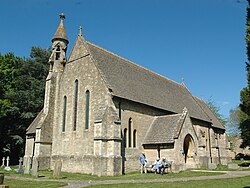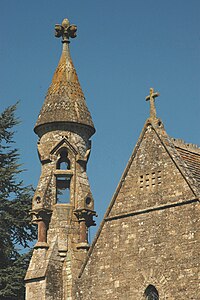Hailey, Oxfordshire
| Hailey | |
| Oxfordshire | |
|---|---|
 St John the Evangelist parish church | |
| Location | |
| Grid reference: | SP347122 |
| Location: | 51°48’29"N, 1°29’52"W |
| Data | |
| Population: | 1,208 (2011, with New Yatt) |
| Post town: | Witney |
| Postcode: | OX29 |
| Dialling code: | 01993 |
| Local Government | |
| Council: | West Oxfordshire |
| Parliamentary constituency: |
Witney |
| Website: | haileywestoxon.org |
Hailey is a village about two miles north of Witney, Oxfordshire. The village comprises three neighbourhoods: Middletown on the main road between Witney and Charlbury, Poffley End on the minor road to Ramsden and Delly End on Whiting's Lane. The parish extends from the River Windrush in the south, almost to the village of Ramsden and the hamlet of Wilcote in the north, and it includes the hamlet of New Yatt. The 2011 Census recorded the parish's population as 1,208.
Church and chapel
A Church of England parish church was built in 1761[1] and extended in 1830.[2] It was demolished and replaced by the present Gothic Revival parish church of St John the Evangelist in 1866–69. It was designed by the young Gothic Revival architect Clapton Crabb Rolfe, whose father Rev. George Crabb Rolfe was the perpetual curate. C.C. Rolfe applied his own interpretation of French Gothic architecture. The Oxford Diocesan Architect George Edmund Street condemned his initial designs as "needlessly eccentric", so Rolfe modified them. But Sherwood and Pevsner describe the result as "still odd... a fantastic Gothic in colourful materials with bulbous forms and freakish detail". They single out the bell-turret as "particularly bizarre".[3] The font, sited in the north aisle, is from the preceding Georgian parish church.[1] St John's is a Grade II* listed building.[4] Its parish is part of the Benefice of Witney, which also includes Curbridge.
A Methodist chapel was built in 1908.[1] It is now a private house.[2]
History
The Old Manor House at Poffley End was a small house built of Cotswold stone in the 15th century, and was enlarged to its present size in the 16th and 17th centuries.[1] It is a Grade II* listed building.[5] Delly End has a terrace of 17th century cottages. Swanhall Farm, east of Poffley End, was built in about 1700. Hailey Manor at Delly End is an ashlar-fronted early Georgian house of six bays.[1][6]
The ancient Wychwood royal forest included the whole of Hailey, and the northern part of the parish was mostly woodland, wood-pasture and heath. But from the 13th century onwards assarting reduced the woodland in the north and east of the parish. The endings of local toponyms including Delly, Hailey and Poffley all come from leah, Middle English for a "clearing".[7] The southwest of the parish was farmed on an open field system. Villagers seem to have enlarged the open fields by assarting in the 13th and 14th centuries, and by the early 17th century their combined area was 470 acre. Parliament passed an inclosure act for Hailey in 1821, which was implemented in 1822–24.[7]
From the early 13th century there was a fulling mill on the Windrush in the south of the parish. It was run down in the latter half of the century, seems to have ceased trading by 1318 and may have been demolished. In the 1580s Thomas Box of Witney bought Burycroft, the land next to the former mill site, and had a new leat dug and mill built. By 1589 it was in production, and it has been called New Mill ever since. From the early 17th century, trades including fulling or tucking, broadweaving and clothing are frequently recorded in Hailey.[7] By the middle of the 18th century blanket-making dominated Hailey's wool trade as it did Witney's.
By the early 19th century more families seem to have worked in trade and industry than in agriculture. In the early history of the trade many weavers worked at home, but in the 18th and 19th centuries New Mill increasingly dominated Hailey's cloth trade. This was despite fires damaging the mill in the late 18th century and in 1809, 1818 and 1883.[7] The Early family of Witney blanket-makers were renting at least part of the mill by 1818 and operating the whole premises by the 1820s. Legally the mill was in two parts, and in 1830 the Earlys bought one part copyhold and the other part leasehold. Earlys bought the freehold in 1894 and continued blanket-making there until the mid-1960s. It has since been converted to other trades.[7]
Mr T. Harris had a smithy at Witheridge Farm, south of Hailey. Upon his death in February 1960 many of his tools were donated to The Museum of English Rural Life.[8]
About the village
Hailey has an 18th-century public house: the Lamb and Flag.[9] The name is a reference to the parish church being dedicated to St John the Evangelist, whose Gospel of John is the source of the Lamb of God as a traditional symbol of Christ.
==Sport:
Outside links
| ("Wikimedia Commons" has material about Hailey, Oxfordshire) |
References
- ↑ 1.0 1.1 1.2 1.3 1.4 Sherwood & Pevsner 1974, p. 629.
- ↑ 2.0 2.1 "Hailey". Oxfordshire Churches & Chapels. Brian Curtis. http://www.oxfordshirechurches.info/Hailey.htm.
- ↑ Sherwood & Pevsner 1974, p. 628.
- ↑ National Heritage List 1367964: Church of St John the Evangelist (Grade II* listing)
- ↑ National Heritage List 1198776: The Old Manor House (Grade II* listing)
- ↑ National Heritage List 1198737: Hailey Manor (Grade II listing)
- ↑ 7.0 7.1 7.2 7.3 7.4 Townley 2004, pp. 236–247.
- ↑ "Harris, T (rural tools collector)". The Museum of English Rural Life. https://merl.reading.ac.uk/collections/harris/.
- ↑ National Heritage List 1052983: The Lamb and Flag Public House (Grade II listing)
- ↑ Hailey Cricket Club
- ↑ Witney Rugby Football Club
- Haskell, John (2011). Hailey's Anglican Churches 250 years 4th August 1761–2011 Church and Church Life. Hailey: Hailey District Church Council.
- Nikolaus Pevsner: The Buildings of England: Oxfordshire, 1974 Penguin Books ISBN 978-0-300-09639-2
- Sturdy, David (1961–62). "The Old Manor House, Poffley End, Hailey, Oxon". Oxoniensia (Oxford Architectural and Historical Society) XXVI–XXVII: 321–323. http://oxoniensia.org/volumes/1961-2/sturdy3.pdf.
- A History of the County of Oxford - Volume 14 pp 225-255: Witney and its Townships (Victoria County History)



